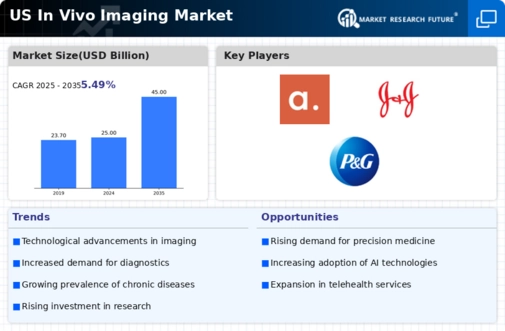Advancements in Imaging Technologies
Technological innovations in imaging modalities, such as MRI, PET, and CT scans, are significantly influencing the in vivo-imaging market. The introduction of high-resolution imaging techniques and hybrid imaging systems is enhancing diagnostic accuracy and enabling earlier disease detection. For instance, the market for MRI systems alone is projected to reach $6 billion by 2026, driven by advancements in software and hardware capabilities. These developments not only improve the quality of images but also reduce the time required for diagnosis, thereby increasing the efficiency of healthcare delivery. As a result, the in vivo-imaging market is likely to experience robust growth as healthcare facilities adopt these cutting-edge technologies to meet the rising demand for precise and timely diagnostics.
Rising Prevalence of Chronic Diseases
The increasing incidence of chronic diseases such as cancer, cardiovascular disorders, and neurological conditions is a primary driver for the in vivo-imaging market. As the population ages, the demand for advanced diagnostic tools that can provide real-time insights into disease progression is escalating. In 2025, it is estimated that chronic diseases will account for approximately 70% of all deaths in the US, highlighting the urgent need for effective imaging solutions. The in vivo-imaging market is poised to benefit from this trend, as healthcare providers seek innovative technologies to enhance patient outcomes and streamline treatment protocols. Furthermore, the integration of imaging modalities with therapeutic interventions is likely to create new opportunities for growth within the market.
Increasing Focus on Preventive Healthcare
The shift towards preventive healthcare is significantly impacting the in vivo-imaging market. As healthcare systems emphasize early detection and prevention of diseases, the demand for imaging technologies that facilitate routine screenings and assessments is on the rise. This trend is reflected in the growing number of health initiatives aimed at promoting regular imaging tests for at-risk populations. In 2025, it is projected that preventive imaging services will constitute a larger segment of the overall imaging market, driven by increased awareness and patient engagement. The in vivo-imaging market is expected to benefit from this focus on prevention, as healthcare providers seek to implement imaging solutions that support proactive health management and improve overall population health.
Growing Investment in Research and Development
Investment in research and development (R&D) within the healthcare sector is a crucial driver for the in vivo-imaging market. Increased funding from both public and private sectors is facilitating the development of novel imaging techniques and applications. In 2025, R&D spending in the US healthcare sector is expected to exceed $200 billion, with a significant portion allocated to imaging technologies. This influx of capital is likely to accelerate innovation, leading to the introduction of advanced imaging solutions that cater to specific medical needs. Consequently, the in vivo-imaging market stands to gain from enhanced product offerings and improved imaging capabilities, ultimately benefiting patient care and treatment outcomes.
Integration of Artificial Intelligence in Imaging
The integration of artificial intelligence (AI) into imaging technologies is transforming the landscape of the in vivo-imaging market. AI algorithms are being utilized to analyze imaging data, improving diagnostic accuracy and reducing interpretation time. This trend is particularly relevant in oncology, where AI can assist in identifying tumors at earlier stages. By 2025, it is anticipated that AI-driven imaging solutions will account for a substantial share of the market, as healthcare providers increasingly adopt these technologies to enhance clinical decision-making. The in vivo-imaging market is likely to see a surge in demand for AI-integrated systems, which can provide more precise and efficient diagnostic capabilities, ultimately leading to better patient outcomes.














Leave a Comment